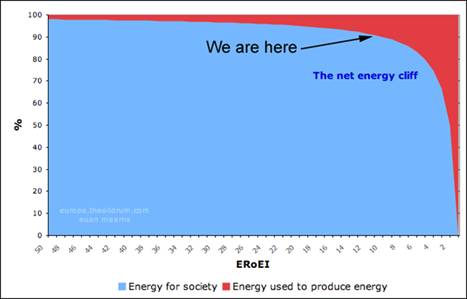(October 29, 2012)
It doesn’t matter how abundant liquid fossil fuels might be; it’s their cost
that impacts the economy.
Many people think “peak oil” is about the world is “running out of oil."
Actually, “peak oil” is about the world running out of cheap, easy-to-get oil. That
means fossil fuels might be abundant (supply exceeds demand) for a time but still remain expensive.
The abundance or scarcity of energy is only one factor in its price. As the cost of
extraction, transport, refining, and taxes rise, so does the “cost basis” or the total
cost of production from the field to the pump. Anyone selling oil below its cost basis
will lose money and go out of business.
We are trained to expect that anything that is abundant will be cheap, but energy is a
special case: it can be abundant but costly, because it’s become costly to produce.
EROEI (energy returned on energy invested) helps illuminate this point. In the good
old days, one barrel of oil invested might yield 100 barrels of oil extracted and refined
for delivery. Now it takes one barrel of oil to extract and refine 5 barrels of oil,
or perhaps as little as 3 barrels of unconventional or deep sea oil.
In the old days, oil would shoot out of the ground once a hole was drilled down to the
deposit. All the easy-to-find, easy-to-get oil has been consumed; now even Saudi Arabia
must pump millions of gallons of water into its wells to push the oil up out of the ground.
Recent discoveries of oil are in costly locales deep offshore or in extreme conditions.
It takes billions of dollars to erect the platforms and wells to reach the oil, so the
cost basis of this new oil is high.
It doesn’t matter how abundant liquid fossil fuels might be; it’s their cost that impacts the economy.
High energy costs mean households must spend more of their income on energy, leaving
less for savings and consumption. High energy costs act as a hidden “tax” on the economy,
raising the price of everything that uses energy.
As household incomes drop and vehicles become more efficient, demand for gasoline declines.
Normally, we would expect lower demand to lead to lower prices. But since the production
costs of oil have risen, there is a “floor” for the price of gasoline. As EROEI drops,
the price floor rises, regardless of demand.
This decrease in real incomes and ratcheting-higher energy costs could lead to a situation
where energy is abundant but few can afford to buy much of it.
The relative abundance of fracked natural gas and low-energy density fossil fuels
like tar sands and shale has led to a media frenzy that confuses abundance with low cost.
This article (via correspondent Steve K.) illustrates the tone and breezy selection of
data to back up the "no worries, Mate" forecast of abundant cheap liquid fuels:
An economy awash in oil. (MacLeans)
Not so fast, reports Rex Weyler of the
Deep Green Blog. Here is Rex's response to the above article.
Fair point about the volume of unconventional – deepwater, shale gas & oil, tar sands, etc.
– hydrocarbons. These reserves may even produce peakies and/or sustain the plateau longer
than some observers believe. However, biophysical restraints remain real; peak oil remains
real; peak net energy appears imminent, and the impact on economies is already being
felt globally. Points to consider:
The dregs: In spite of huge shale & tar reserve discoveries, peak discoveries
remain well behind us, in the 1960s. My father, a petroleum geologist his entire life
(and still, in Houston, Kazakstan...), knew about shale and tar deposits when I was
a teenager in the 1960s. He called them "the dregs." These deposits are not really news
within the oil industry. And they are the dregs because of high cost, low EROI and rapid
depletion.
EROI: The volume of these low-net-energy reserves could extend peak oil production for
decades, but at fast-declining net energy returned to society. We high-graded Earth’s
hydrocarbons, just as we high-graded the forests, fish, copper, tin, water, and so forth.
We’ve taken the best, highest EROI hydrocarbons, the 100:1 free-flowing wells of the 1930s
and 40s. We’re now into the 3:1 and 2:1 tar sands.
For example: damming rivers in Northern BC, to send electricity to the fracking fields,
to send shale gas to Alberta, to cook the boreal substrate, and mix the black sludge with
gas condensate shipped in from California and by pipeline from Kitimat to Fort McMurray,
to mix with the bitumen, to pipe to Vancouver Harbour, to ship to China, to burn in a
power plant, to supply electricity to their manufacturing empire.
By the time any of this
energy gets used to actually make something useful to someone in society, and by the
time that user puts that usefulness to work to feed, clothe, house, or heal anyone,
there is no net-energy left.
Our food in North America is already negative net energy
by1:10 at best, up to 1:17 or worse for much of the crap we eat. This matters.
EROI at well-head, EROI at the consumer pump, and EROI at the point of society’s actual
service all matter.
Well-head EROI, counting all public subsidies, is now in the 5:1 to 1:1 range for all
these “non-conventional” (meaning the dregs) hydrocarbon deposits. Money can be made.
Some energy can be delivered to Society, but this is already way below the well-head EROI
that could likely run the current complexity of the human society, much less “grow”
economies.
The degrading reserves take us down along the EROI curve, in which Net Energy returned to
society falls off a cliff around 6:1, and is in freefall by 3:1. Net-energy alone kills the
idea of much economic growth from a booming hydrocarbon bonanza (other than some great
stock plays along the way). Furthermore, depletion renders the idea ever more unlikely:
Depletion: Depletion rates on these gas fields have arrived quickly and appear
drastic by historic industry standards. The fracking fields peak early and decline swiftly.
In the Bakken shale field – one of the great North American saviour fields – the average
well has produced ~ 85k barrels in its first year and then declined at about 40% per year.
The newer average wells peak earlier and decline faster, so the overall trend is down.
The depletion moves the production process along a function that approaches zero net
energy... Down we go along the EROI curve... 5:1 .. 4:1 .. 3 .. 2 ... and then really
complex society breaks down. An Amish farmer gets 10:1.
The Bakken break-even oil price is $85, so there is no profit in any of this right now,
but of course there will be if global depletion exceeds demand from crashing economies.
Depletion – both in volume and quality – and depletion for all industrial materials and
energy stores, EROI, and economic stagnation all work as feedback loops. No one knows
the bifurcation points in this complex system. We try to predict those, but miss by a
longshot sometimes. Complex societies crash in this manner, declining returns on
investments in complexity, from Babylon to London and Washington. See J. Tainter,
H. Odum, N. Georgescu-Roegen, Hall, Cleveland, et al.
Here are some depletion data on The Oil Drum:
Is Shale Oil Production from Bakken Headed for a Run with “The Red Queen”?.
See
A Review of the Past and Current State of EROI Data (PDF) by Hall, Cleveland, et al. (source:
www.mdpi.com)
There is a lot of EROI data here: Obstacles Facing US Wind Energy. (The Oil Drum)
Below is the EROI curve, only the “We are here” point at 10:1 is the modern average, and
from a few years ago. The new conventional stuff is coming in lower and and the enhanced
recovery, shale and tar fields are already over the falls at 6 or 5:1 for the better stuff
(best dregs), and 3:1 to 1:1 for the dregs of the dregs, the deeper shale and tar sands.

So yes, our friends are correct about the great volume of tar, shale, deep, heavy
hydrocarbons, but increasing production of world liquid hydrocarbons much beyond the
current 85mb/d is not likely, and increasing net production is even less likely.
As you may know, net production per capita peaked in 1979. Actual net production is
peaking now. This is the figure that counts: Actual current Net Production Delivered to
Society.
Growing this figure is technically possible, and may happen with some massive production
bonanzas, i.e. we may see actual production push above 90mb/day, or higher, and may
even see net production increase, but a major glut of hydrocarbons? No. Not remotely.
When settlers first came to North America, they found copper nuggets the size of horses
exposed in river beds. China just bought the best known, last, huge, moderate-to-low-grade,
strip-minable, high-cost copper field in the world, in Afghanistan, for $billions over the
western bids. There will be others, but rest assured: They will be lower grade, higher
cost, and the competition will be more intense. When was the last time you bought a
“copper” fitting at the hardware store. They’re crap. The alloys are crap. Because the ore
quality is in decline and the costs of extraction are rising. Same with oil, trees, tin,
coal....
Make no mistake: The war for the dwindling materials and energy flow is well underway.
Thank you, Rex, for this commentary on EROI and the quality and cost of hydrocarbon
resources.
Complex systems like economies are nonlinear, and so history does not necessarily track linear
extrapolations of present trends. With that caveat in mind, the preponderance of evidence supports the
notion that fossil fuel energy may remain abundant in the sense that supply meets or
exceeds demand in a global recession, but the price of liquid fuels may remain high enough
to create a drag on growth, employment, tax revenues and all the other economic
metrics impacted by high energy costs.
 Resistance, Revolution, Liberation: A Model for Positive Change
(print $25)
Resistance, Revolution, Liberation: A Model for Positive Change
(print $25)
(Kindle eBook $9.95)
Read the Introduction
(2,600 words) and Chapter One (7,600 words) for free.
We are like passengers on the Titanic ten minutes after its fatal encounter with the iceberg: though our financial system seems unsinkable, its reliance on debt and financialization has already doomed it.
We cannot know when the Central State and financial system will destabilize, we only know they will destabilize. We cannot know which of the State’s fast-rising debts and obligations will be renounced; we only know they will be renounced in one fashion or another.
The process of the unsustainable collapsing and a new, more sustainable model emerging is
called revolution.
Rather than being powerless, we hold the fundamental building blocks of power. We need neither
permission nor political change to liberate ourselves. A powerless individual becomes
powerful when he renounces the lies and complicity that enable the doomed Status Quo’s
dominance.

If this recession strikes you as different from previous downturns, you might
be interested in my book
An Unconventional Guide to Investing in Troubled Times (print edition)
or
Kindle ebook format. You can read the ebook on any
computer, smart phone, iPad, etc. Click here for links to Kindle apps and Chapter One.
The solution in one word: Localism.
Readers forum:
DailyJava.net.

Order Survival+: Structuring Prosperity for Yourself and the Nation
(free bits)
(Kindle) or
Survival+ The Primer
(Kindle)
or Weblogs & New Media: Marketing in Crisis
(free bits)
(Kindle) or from your local bookseller.
Of Two Minds Kindle edition:
Of Two Minds blog-Kindle

"This guy is THE leading visionary on reality.
He routinely discusses things which no one else has talked about, yet,
turn out to be quite relevant months later."
--Walt Howard, commenting about CHS on another blog.
NOTE: gifts/contributions are acknowledged in the order received. Your name and email
remain confidential and will not be given to any other individual, company or agency.
|
|
Thank you, Karl L. ($50), for yet another superbly generous contribution
to this site--I am greatly honored by your ongoing support and readership.
|
|
Or send him coins, stamps or quatloos via mail--please
request P.O. Box address.
Subscribers ($5/mo) and contributors of $50 or more
this year will receive a
weekly email of exclusive (though not necessarily coherent) musings and amusings.
At readers' request, there is also a $10/month option.
What subscribers are saying about the Musings
(Musings samples here):
The "unsubscribe" link is for when you find the usual drivel here
insufferable.
Your readership is greatly appreciated with or without a donation.
For more on this subject and a wide array of other topics, please visit
my weblog.
All content, HTML coding, format design, design elements and images copyright ©
2012 Charles Hugh Smith, All rights
reserved in all media, unless otherwise credited or noted.
I would be honored if you linked this essay to your site, or printed a copy for your own use.
Terms of Service:
All content on this blog is provided by Trewe LLC for informational purposes only. The owner of this
blog makes no representations as to the accuracy or completeness of any information
on this site or found by following any link on this site. The owner will not be liable
for any errors or omissions in this information nor for the availability of this information.
The owner will not be liable for any losses, injuries, or damages from the display or
use of this information. These terms and conditions of use are subject to change at
anytime and without notice.



 Resistance, Revolution, Liberation: A Model for Positive Change
(print $25)
Resistance, Revolution, Liberation: A Model for Positive Change
(print $25)

